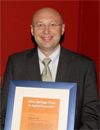Jul 8 2007
The STED (stimulated emission depletion) microscope invented by Hell is the first optical microscope to show details in resolutions far below the light wavelength using conventional lenses.
 Julius Springer Prize for Applied Physics 2007 awarded to Stefan W. Hell for his revolutionary work on light microscopy
Julius Springer Prize for Applied Physics 2007 awarded to Stefan W. Hell for his revolutionary work on light microscopy
This technique opens up new possibilities in the life sciences because it allows non-invasive imaging of the inside of cells. The prestigious award from the scientific publisher Springer will be awarded for the tenth time this year and carries prize money of US $5,000. Stefan Hell will receive the prize during a plenary session at the trade show Laser.World of Photonics 2007 in Munich on 19 June.
Stefan Hell has been a researcher at the Max Planck Institute for Biophysical Chemistry in Göttingen since 1997. This is where he and his colleagues conducted the first basic experiments to overcome the limit of resolution. Ever since the work carried out by Ernst Abbe in 1873, half the light's wavelength has been considered a practically unsurpassable limit in light microscopes that use focused visible light. In an STED microscope, the effective focal spot of fluorescence emission on the focal plane of the lens is radically decreased, allowing nanoscale imaging. Resolutions 10 -12 times higher than the diffraction limit have been obtained so far. In principle, however, STED microscopes can achieve molecular resolutions, because the effective focal spot can be reduced indefinitely due to the almost exponential depletion of the fluorescent state.
Hell's pioneering research has attracted attention from throughout the world and has been published in a number of scientific journals in this field. He is a scientific member of the Max Planck Society, adjunct professor of physics at the University of Heidelberg, honorary professor of experimental physics at the University of Göttingen and a member of the Göttingen Academy of Sciences. He has received numerous research prizes in Germany and abroad, including the Prize of the International Commission for Optics (2000), the Carl Zeiss Research Award (2002) and last year's German Innovation Award presented by the German President.
The Julius Springer Prize for Applied Physics recognizes researchers who have made an outstanding and innovative contribution to the field of applied physics. It has been awarded annually since 1998 by the editors-in-chief of the Springer journals Applied Physics A – Materials Science & Processing and Applied Physics B – Lasers and Optics.